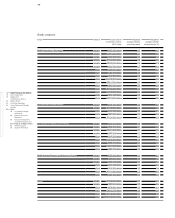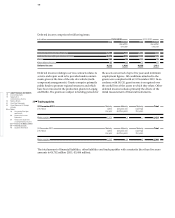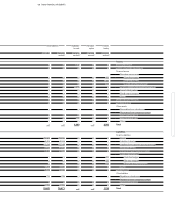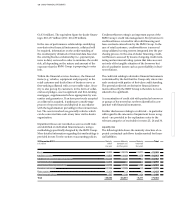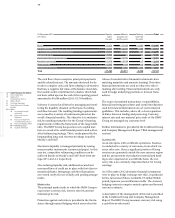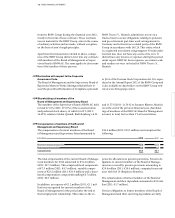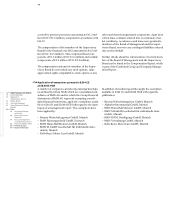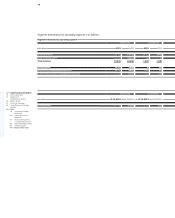BMW 2012 Annual Report Download - page 136
Download and view the complete annual report
Please find page 136 of the 2012 BMW annual report below. You can navigate through the pages in the report by either clicking on the pages listed below, or by using the keyword search tool below to find specific information within the annual report.
136
78 GROUP FINANCIAL STATEMENTS
78 Income Statements
78 Statement of
Comprehensive Income
80 Balance Sheets
82 Cash Flow Statements
84 Group Statement of Changes
in Equity
86 Notes
86 Accounting Principles
and Policies
100 Notes to the Income
Statement
107 Notes to the Statement
of Comprehensive Income
108
Notes to the Balance Sheet
129 Other Disclosures
145 Segment Information
Fair value gains and losses recognised on derivatives and
recorded initially in accumulated other equity are re-
classified to cost of sales when the derivatives mature.
A net positive amount of € 1 million (2011: net negative
amount of € 2 million) attributable to forecasting errors
(and the resulting over-hedging of currency exposures)
was recognised within the line item “Financial Result” in
the financial year 2012. These forecasting errors, which all
related to the year under report, arise primarily as a result
of changes in sales forecasts in foreign currencies. In addi-
tion, cash flow hedges of raw materials gave rise to a net
expense of € 8 million (2011: € – million) from forecasting
errors and net income of € 67 million (2011: net expense
of € 52 million) from ineffectiveness, which were also rec-
ognised
within the line item “Financial Result”.
At 31 December 2012 the BMW Group held derivative
instruments (mainly option and forward currency con-
tracts) with terms of up to 72 months (2011: 54 months),
as a general rule in order to hedge currency risks at-
tached to future transactions. These derivative instru-
ments
are intended to hedge forecast sales denominated
in a foreign currency over the coming 72 months. The
income statement impact of the hedged cash flows will
be recognised as a general rule in the same periods in
which external revenues are recognised. It is expected
that € 26 million of net gains, recognised in equity at
the end of the reporting period, will be recognised in
the income statement in 2013.
The difference between the gains / losses on hedging
instruments (mostly interest rate swaps) and the results
recognised on hedged items represents the ineffective
portion of fair value hedges.
Fair value hedges are mainly used to hedge the market
prices of bonds, other financial liabilities and receivables
from sales financing.
At 31 December 2012 the BMW Group held derivative
instruments (mostly interest rate swaps) with terms
of up to 25 months (2011: 60 months) to hedge interest
rate risks. These derivative instruments are intended
to
hedge interest rate risks arising on financial instru-
ments with variable interest payments over the coming
25 months. The income statement impact of the hedged
cash flows will be recognised as a general rule in the
same periods over which the relevant interest rates are
fixed. It is not expected that any net gains or net losses,
recognised in equity at the end of the reporting period,
will be reclassified to the income statement in 2013.
At 31 December 2012, the BMW Group held derivative
instruments (mostly commodity swaps) with terms of
up to 60 months (2011: 55 months) to hedge raw mate-
rials price risks attached to future transactions over the
coming 60 months. The income statement impact of
the hedged cash flows will be recognised as a general
rule in the same period in which the derivative instru-
ment
matures. It is expected that € 5 million of net
gains, recognised in equity at the end of the reporting
period, will be recognised in the income statement in
2013.
Fair value hedges
The following table shows gains and losses on hedging
instruments and hedged items which are deemed to
be part of a fair value hedge relationship:
Bad debt risk
Notwithstanding the existence of collateral accepted,
the carrying amounts of financial assets generally take
account of the maximum credit risk arising from the
possibility that the counterparties will not be able to
fulfil their contractual obligations. The maximum credit
risk for irrevocable credit commitments relating to
credit card business amounts to € 969 million (2011:
in € million 31. 12. 2012 31. 12. 2011
Gains / losses on hedging instruments designated as part of a fair value hedge relationship 127 213
Gains / loss from hedged items – 140 – 225
Ineffectiveness of fair value hedges – 13 –12
in € million 2012 2011
Balance at 1 January – 750 – 127
Total changes during the year 952 – 623
of which recognised in the income statement during the period under report 532 – 68
Balance at 31 December 202 – 750
fact that the impact is not material, the BMW Group
does not discount assets for the purposes of determin-
ing impairment losses.
Cash flow hedges
The effect of cash flow hedges on accumulated other
equity was as follows:


